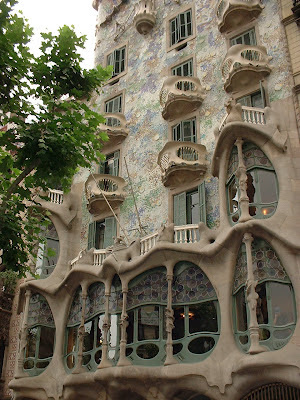Leon
At the heart of the “Pilgrimage Route” to the Santiago de Compostella is Leon, an absolutely charming medieval town. It was perfect place for strolling and hanging out in little cafés and tapas bars, and while there, my husband and I felt as if we’d stepped back in time or were in a classic black & white European film … absolutely enchanting!
Aragon & Santo Domingo de Silos
 |  |
By the time we had arrived in Aragon, the entire region was experiencing an unusual heat wave, and as beautiful as the scenery was, going through the desert climate in the 100 degree heat in a car without an a/c was a challenge, to say the least.
Also, upon arrival in Santo Domingo de Silos, we discovered that our lovely hotel, Tres Coronas de Silos, was also unequipped with an a/c as with most of the historically significant buildings in Europe, and all we could managed to do that evening was to seek refuge in a café and wait for the scorching sun to set. Luckily, it turned out that most tour buses and tourists who visit the town during the day leave shortly before the sunset, making evenings a better time to sight-see, and my husband and I felt as if we had the entire town for ourselves. In the evenings, we dined in little mom and pop restaurants overlooking the monastery and the mountains of Aragon, just enjoying the tranquility of the night.
Also, upon arrival in Santo Domingo de Silos, we discovered that our lovely hotel, Tres Coronas de Silos, was also unequipped with an a/c as with most of the historically significant buildings in Europe, and all we could managed to do that evening was to seek refuge in a café and wait for the scorching sun to set. Luckily, it turned out that most tour buses and tourists who visit the town during the day leave shortly before the sunset, making evenings a better time to sight-see, and my husband and I felt as if we had the entire town for ourselves. In the evenings, we dined in little mom and pop restaurants overlooking the monastery and the mountains of Aragon, just enjoying the tranquility of the night.
Zaragoza (Saragossa)
 |
| Aljafería Palace |
The heat wave was relentless by the time we’d arrived in Zaragoza. Nevertheless, we managed to walk around and explore this picturesque city rich in history and heritage. Zaragoza is one of the great monumental towns in Spain. It was founded some 2000 years ago, and Old-Iberians, Romans, Goths and Arabians equally left their heritage.
We also found a stunning legacy of monuments in the streets of the city, a wonderful mixture of the Roman, Moorish, Jewish and Christian communities who left their mark on the place: Roman ruins such as the Circus; Aljafería Palace; Mudejar-style churches, with the UNESCO World Heritage designation; Baroque gems like the Pilar Basilica; and the work of brilliant artist Francisco de Goya.
Barcelona
Of course, no trip to Northern Spain would be complete without visiting Barcelona, which is without a doubt one of the most vibrant and fascinating cities in Europe.
Aside from the fact that we could have spent the entire week just walking around and visiting the works of Antoni Gaudí, we really enjoyed strolling through the city and exploring the more residential neighborhoods outside of la Rambla and the main tourist area.
 |  |
 |  |
 |  |
 |  |
 |  |
And although when people think of Barcelona, they think of paellas and tapas, we found that other ethnic foods, such as Persian/Iranian and Indonesian were great too, and our favorite dining experiences turned out to be at a wonderful Iranian restaurant called Persa near Passeig de Gracia.
We also stayed in 2 places near the center that were fairly inexpensive, comfortable and clean: Hostal Goya, a modern and impeccably clean hotel in Urquinaona, and Hostal Operaramblas, which was a bit more generic … a little like a dorm … but in the center near la Rambla. I also recommend the website Inns of Spain, which has always helped me in finding wonderfully charming hotels and inns throughout Spain.
Also, la Boqueria just off of la Rambla was a fantastic experience. It is perhaps one of the largest markets I’d seen in Europe, and it had a great selection of items (fresh produce, juices, nuts, cheese, olives and of course, all sorts of jambon) ideal for a picnic.
Spending the last week in Barcelona was a wonderful way to end our 3 week trip to Northern Spain, and it truly was an unforgettable experience.
Northern Spain, A Cultural Pilgrimage and Culinary Odyssey (Part 1)




0 comments:
Post a Comment